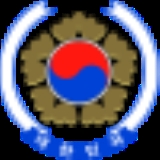
Coat of arms of South Korea
Encyclopedia
The National Emblem of the Republic of Korea (Hangul
: 대한민국의 국장; Hanja
: ) consists of the taeguk
symbol present on the country's national flag
surrounded by five stylized petals and a ribbon bearing the inscription "The Republic of Korea
" (Daehan Minguk), the official name of the country
, in Hangul
characters. The Taegeuk represents peace and harmony. The five petals all have meaning and are related to Korea's national flower (the Hibiscus syriacus
, or Rose of Sharon
). It was adopted in 1963.
Hangul
Hangul,Pronounced or ; Korean: 한글 Hangeul/Han'gŭl or 조선글 Chosŏn'gŭl/Joseongeul the Korean alphabet, is the native alphabet of the Korean language. It is a separate script from Hanja, the logographic Chinese characters which are also sometimes used to write Korean...
: 대한민국의 국장; Hanja
Hanja
Hanja is the Korean name for the Chinese characters hanzi. More specifically, it refers to those Chinese characters borrowed from Chinese and incorporated into the Korean language with Korean pronunciation...
: ) consists of the taeguk
Taeguk
Taegeuk refers to the ultimate reality from which all things and values originate according to oriental philosophy. It is also the symbol that makes up the center of the Korean Flag.-History:...
symbol present on the country's national flag
Flag of South Korea
The flag of South Korea, or Taegeukgi has three parts: a white background; a red and blue taegeuk in the centre; and four black trigrams, one in each corner of the flag...
surrounded by five stylized petals and a ribbon bearing the inscription "The Republic of Korea
South Korea
The Republic of Korea , , is a sovereign state in East Asia, located on the southern portion of the Korean Peninsula. It is neighbored by the People's Republic of China to the west, Japan to the east, North Korea to the north, and the East China Sea and Republic of China to the south...
" (Daehan Minguk), the official name of the country
Names of Korea
There are various names of Korea in use today, derived from ancient kingdoms and dynasties. The modern English name Korea is an exonym derived from the Goryeo period and is used by both North Korea and South Korea in international contexts...
, in Hangul
Hangul
Hangul,Pronounced or ; Korean: 한글 Hangeul/Han'gŭl or 조선글 Chosŏn'gŭl/Joseongeul the Korean alphabet, is the native alphabet of the Korean language. It is a separate script from Hanja, the logographic Chinese characters which are also sometimes used to write Korean...
characters. The Taegeuk represents peace and harmony. The five petals all have meaning and are related to Korea's national flower (the Hibiscus syriacus
Hibiscus syriacus
Hibiscus syriacus is a widely cultivated ornamental shrub in the genus Hibiscus. Common names include Rose of Sharon , Shrub Althea and Rose Althea.-Growth:...
, or Rose of Sharon
Rose of Sharon
Rose of Sharon is a common name that applies to several different species of flowering plants that are highly valued throughout the world. The name's colloquial application has been used as an example of the lack of precision of common names, which potentially causes confusion...
). It was adopted in 1963.
See also
- Flag of South KoreaFlag of South KoreaThe flag of South Korea, or Taegeukgi has three parts: a white background; a red and blue taegeuk in the centre; and four black trigrams, one in each corner of the flag...
- Emblem of North Korea
- Imperial Seal of Korea, uses plum blossom instead
- Yin and yangYin and yangIn Asian philosophy, the concept of yin yang , which is often referred to in the West as "yin and yang", is used to describe how polar opposites or seemingly contrary forces are interconnected and interdependent in the natural world, and how they give rise to each other in turn. Opposites thus only...

